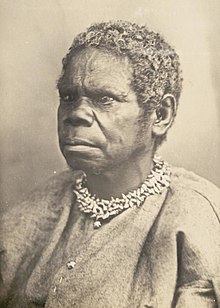
Back Truganini AST Truganini Breton Truganini Catalan Truganini German Truganini Spanish Truganini Basque Truganini Finnish Truganini French Truganini Galician Տրուգանինի Armenian
Truganini | |
|---|---|
 Portrait of Truganini by Charles A. Woolley | |
| Born | c. 1812 |
| Died | 8 May 1876 (aged 63–64) |
| Other names | Truganini, Trucanini, Trucaninny, Trugananner, Lydgugee and Lalla Rookh |
| Known for | Being described as the last "full-blooded" Aboriginal Tasmanian |
| Spouses | Woureddy Maulboyheenner Mannapackername William Lanne |
Truganini (c. 1812 – 8 May 1876), also known as Lalla Rookh and Lydgugee,[1] was a woman famous for being widely described as the last "full-blooded" Aboriginal Tasmanian to survive British colonisation. Although she was one of the last speakers of the Indigenous Tasmanian languages, Truganini was not the last Aboriginal Tasmanian.[2]
She lived through the devastation of invasion and the Black War in which most of her relatives died, avoiding death herself by being assigned as a guide in expeditions organised to capture and forcibly exile all the remaining Indigenous Tasmanians. Truganini was later taken to the Port Phillip District where she engaged in armed resistance against the colonists. She herself was then exiled, first to the Wybalenna Aboriginal Establishment on Flinders Island and then to Oyster Cove in southern Tasmania. Truganini died at Hobart in 1876, her skeleton later being placed on public display at the Tasmanian Museum and Art Gallery until 1948. Her remains were finally cremated and laid to rest in 1976.[3]
In being mythologised as "the last of her people", Truganini became the tragic and triumphal symbol of the conquest of British colonists over an "inferior race".[2][4] In modern times, Truganini's life has become representative of both the dispossession and destruction that was exacted upon Indigenous Australians and also their determination to survive the colonial genocidal policies that were enforced against them.[5][2]
- ^ Pybus 2020, p. 310.
- ^ a b c Ryan, Lyndall (2012). Tasmanian Aborigines. Crows Nest: Allen & Unwin. ISBN 9781742370682.
- ^ Pybus, Cassandra (2024). A Very Secret Trade. Crows Nest: Allen & Unwin. ISBN 9781761066344.
- ^ Boyce, James (2008). Van Diemen's Land. Collingwood: Black Inc. ISBN 9781760644819.
- ^ Pybus 2020, p. xvi.